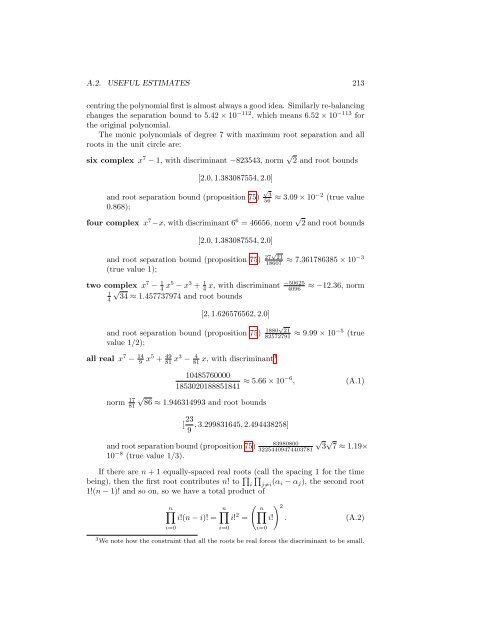Contents - Student subdomain for University of Bath
Contents - Student subdomain for University of Bath
Contents - Student subdomain for University of Bath
You also want an ePaper? Increase the reach of your titles
YUMPU automatically turns print PDFs into web optimized ePapers that Google loves.
A.2. USEFUL ESTIMATES 213<br />
centring the polynomial first is almost always a good idea. Similarly re-balancing<br />
changes the separation bound to 5.42 × 10 −112 , which means 6.52 × 10 −113 <strong>for</strong><br />
the original polynomial.<br />
The monic polynomials <strong>of</strong> degree 7 with maximum root separation and all<br />
roots in the unit circle are:<br />
six complex x 7 − 1, with discriminant −823543, norm √ 2 and root bounds<br />
[2.0, 1.383087554, 2.0]<br />
and root separation bound (proposition 75) √ 3<br />
56 ≈ 3.09 × 10−2 (true value<br />
0.868);<br />
four complex x 7 −x, with discriminant 6 6 = 46656, norm √ 2 and root bounds<br />
[2.0, 1.383087554, 2.0]<br />
and root separation bound (proposition 75) 27√ 21<br />
18607<br />
(true value 1);<br />
≈ 7.361786385 × 10−3<br />
two complex x 7 − 1 4 x5 − x 3 + 1 −50625<br />
4<br />
x, with discriminant<br />
4096<br />
≈ −12.36, norm<br />
√<br />
1<br />
4 34 ≈ 1.457737974 and root bounds<br />
[2, 1.626576562, 2.0]<br />
and root separation bound (proposition 75) 1880√ 21<br />
82572791 ≈ 9.99 × 10−5 (true<br />
value 1/2);<br />
all real x 7 − 14<br />
9 x5 + 49<br />
81 x3 − 4 81<br />
x, with discriminant3<br />
10485760000<br />
1853020188851841 ≈ 5.66 × 10−6 , (A.1)<br />
norm 17<br />
81<br />
√<br />
86 ≈ 1.946314993 and root bounds<br />
[ 23 , 3.299831645, 2.494438258]<br />
9<br />
and root separation bound (proposition 75)<br />
83980800<br />
32254409474403781<br />
√<br />
3<br />
√<br />
7 ≈ 1.19×<br />
10 −8 (true value 1/3).<br />
If there are n + 1 equally-spaced real roots (call the spacing 1 <strong>for</strong> the time<br />
being), then the first root contributes n! to ∏ ∏<br />
i j≠i (α i − α j ), the second root<br />
1!(n − 1)! and so on, so we have a total product <strong>of</strong><br />
n∏<br />
i!(n − i)! =<br />
i=0<br />
(<br />
n∏<br />
n 2<br />
∏<br />
i! 2 = i!)<br />
. (A.2)<br />
i=0<br />
3 We note how the constraint that all the roots be real <strong>for</strong>ces the discriminant to be small.<br />
i=0












![[Luyben] Process Mod.. - Student subdomain for University of Bath](https://img.yumpu.com/26471077/1/171x260/luyben-process-mod-student-subdomain-for-university-of-bath.jpg?quality=85)



